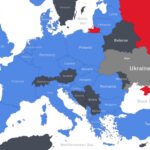
UTÖ, Sweden (June 13, 2016) – A marine from Swedish/Finnish Nyland Brigade amphibious task unit welcomes U.S. Marines aboard a CB90-class fast assault craft in Utö, Sweden, during BALTOPS 2016, June 13. BALTOPS is an annual recurring multinational exercise designed to improve interoperability, enhance flexibility and demonstrate the resolve of allied and partner nations to defend the Baltic region. (U.S. Navy Photo by Mass Communication Specialist Seaman Alyssa Weeks/Released)
A Strategic Culture, the editors suggest that counter to NATO’s suggestion that expansion in Finland will increase peace and prosperity, increased tensions will create a self-fulfilling prophecy of war. They conclude:
With a Nordic frontier of 1,300 kilometers, Finland’s accession to NATO effectively doubles the existing territory on which NATO can install military forces targeting Russia. Finland also affords NATO significantly new access to Baltic Sea lanes proximate to Russia’s coast and maritime routes. Nordic neighbor Sweden is also due to join the military bloc in the coming months. That will mean that, except for Russia, the Baltic Sea is surrounded by eight NATO states: Estonia, Lithuania, Latvia, Poland, Germany, Denmark, Sweden, and Finland. This is part of a wider scramble for Arctic natural resources and a desire to shut Russia out.
It remains to be seen if NATO troops and weapons start deploying substantially in Finland. Jens Stoltenberg, the NATO Secretary-General, said this week that there were no plans for such a move and that it would require Helsinki’s request. A change of government in Finland after elections last week brings in a hawkish pro-NATO Prime Minister Petteri Orpo. Ironically, he was elected because Finnish voters were worried about the economic decline of their country. New NATO military obligations will add to their nation’s burgeoning financial debt and economic woes.
The mere potential, however, of NATO deployment in Finland is sufficient grounds for Russia to condemn the new heightened threat to its national security. Moscow said this week it will respond with reciprocal security measures on Finland’s border.
In a few weeks, NATO is embarking on the largest-ever military games in the organization’s history since its founding in 1949. Exercise Air Defender will involve over 220 warplanes and 10,000 troops from 24 nations, including Finland. It will see the biggest movement of U.S. soldiers to Europe since the end of the Cold War. American commander Lieutenant General Michael Loh said of the exercises: “This is now putting the alliance together quickly, with a credible force, to make sure that if Russia ever lines up on the NATO border, that we’re ready to go.”
It’s preposterous propaganda to claim that Russia is planning to attack any European country. This is the Americans and their allies fantasizing about their own projection and setting up a self-fulfilling prophecy. So, if Russia deploys to the border with Finland, is that adjudged to be “Russian aggression”?
The U.S.-led NATO axis has created today’s dangerous belligerent spiral from its decades of aggressive build-up on Russia’s borders. The current conflict in Ukraine is manifestly the result of the United States and its allies ignoring Russia’s repeated concerns about NATO expansionism and in particular the intended inclusion of Ukraine.
Instead of a reasoned understanding of history, Washington is pushing headlong with increasing NATO hostility toward Russia, ignoring the best advice from some of its most respected thinkers and diplomats, including the late George Kennan, former ambassador to the Soviet Union Jack Matlock and Professor John Mearsheimer.
Among those boasting this week over the accession of Finland to NATO was U.S. President Joe Biden. In a twisted view of history, he said Russia’s alleged attempts to divide NATO had failed by its “unprovoked” assault on Ukraine.
The American president declared that Finland joining NATO was a portent of a more peaceful and secure Europe. Biden said the same thing 24 years ago when NATO was joined by Poland, the Czech Republic, and Hungary, in the first of many waves of post-Cold War expansion. That same year, in 1999, the U.S.-led NATO axis bombed former Yugoslavia for 78 days in the biggest inter-state violence in Europe since the end of World War Two. German troops were deployed along with other NATO forces for the first time since the defeat of the Third Reich in 1945.
Biden and other NATO cheerleaders celebrating “peace” and “security” with Finland joining the bloc this week is not just grotesque. It is a foreboding warning of a more disastrous war.
If you’re willing to fight for Main Street America, click here to sign up for the Richardcyoung.com free weekly email.





